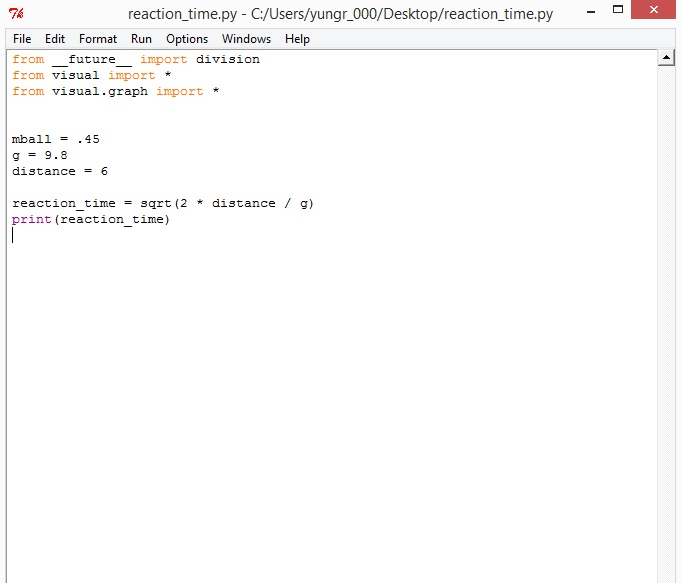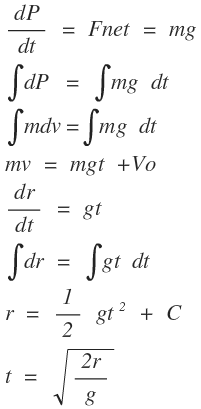Reaction Time: Difference between revisions
No edit summary |
|||
| (15 intermediate revisions by the same user not shown) | |||
| Line 1: | Line 1: | ||
By, Russell Dawkins | By, Russell Dawkins | ||
Reaction time is a physical phenomenon that can be calculated using the momentum principle. | Reaction time is a physical phenomenon that can be calculated using the momentum principle. | ||
==The Main Idea== | ==The Main Idea== | ||
Your reaction time is how long it takes you to respond to an event. This can be measured one of two ways. One way to measure reaction times is given the distance that an object traveled since you reacted to it. Another application of this formula is to solve for the distance that the object caught travels based on how long it took to catch it. | |||
===A Mathematical Model=== | ===A Mathematical Model=== | ||
This picture shows how the momentum principle can be used to derive the two equations associated with reaction time. One equation solves for time and the other solves for the distance. | |||
[[File:reacteq.png]] | |||
===A Computational Model=== | ===A Computational Model=== | ||
This picture shows a vPython code that can solve for the reaction time. | |||
[[File:React.jpg]] | |||
==Examples== | ==Examples== | ||
This youtube link shows a video of a ruler being dropped and caught. The displacement of the ruler was 10 inches so the reaction time was .2267 seconds. | |||
https://www.youtube.com/watch?v=zu1yde207qU&feature=youtu.be | |||
===Further reading=== | ===Further reading=== | ||
A Study in Reaction Time and Movement | '''A Study in Reaction Time and Movement''' | ||
by, Thomas Verner Moore | by, Thomas Verner Moore | ||
Speedy Science: How Fast Can You React? | '''Speedy Science: How Fast Can You React?''' | ||
by, Daisy Yuhas | by, Daisy Yuhas | ||
Latest revision as of 23:07, 5 December 2015
By, Russell Dawkins
Reaction time is a physical phenomenon that can be calculated using the momentum principle.
The Main Idea
Your reaction time is how long it takes you to respond to an event. This can be measured one of two ways. One way to measure reaction times is given the distance that an object traveled since you reacted to it. Another application of this formula is to solve for the distance that the object caught travels based on how long it took to catch it.
A Mathematical Model
This picture shows how the momentum principle can be used to derive the two equations associated with reaction time. One equation solves for time and the other solves for the distance.
A Computational Model
This picture shows a vPython code that can solve for the reaction time.

Examples
This youtube link shows a video of a ruler being dropped and caught. The displacement of the ruler was 10 inches so the reaction time was .2267 seconds. https://www.youtube.com/watch?v=zu1yde207qU&feature=youtu.be
Further reading
A Study in Reaction Time and Movement
by, Thomas Verner Moore
Speedy Science: How Fast Can You React?
by, Daisy Yuhas
